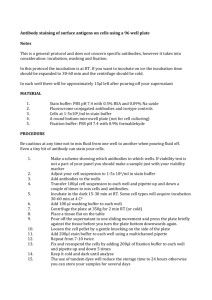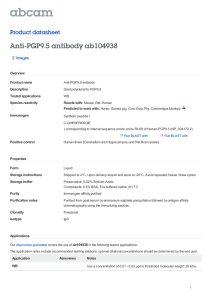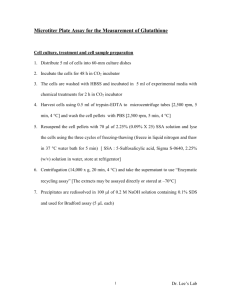ab133983 – ECH1 Human Profiling ELISA Kit
advertisement
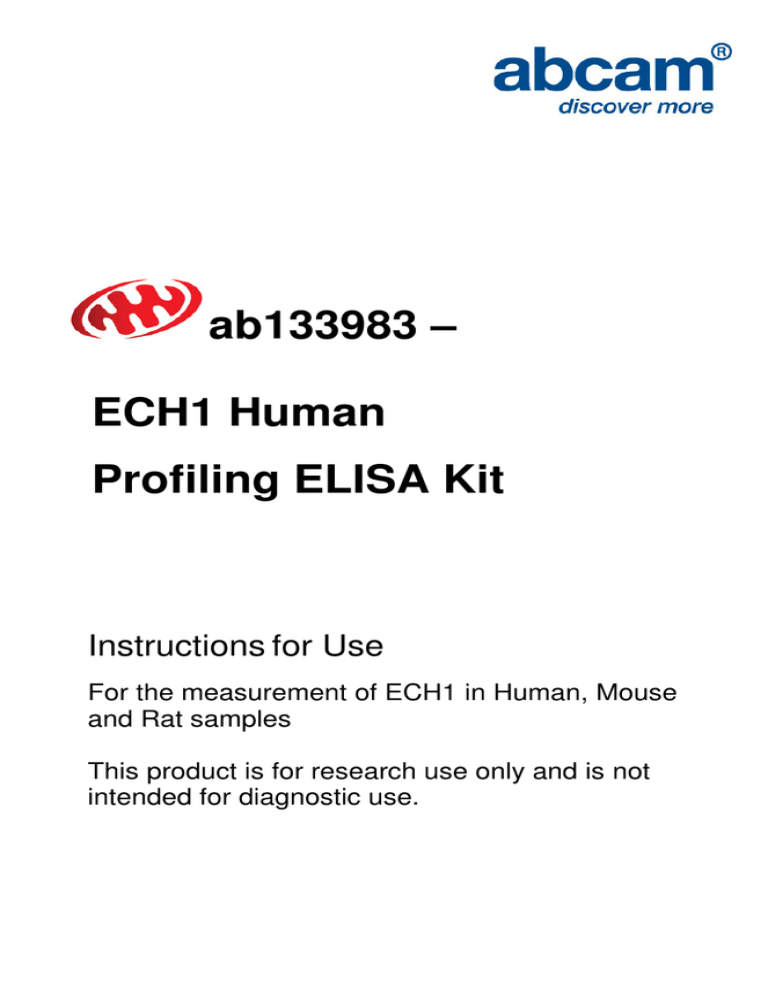
ab133983 – ECH1 Human Profiling ELISA Kit Instructions for Use For the measurement of ECH1 in Human, Mouse and Rat samples This product is for research use only and is not intended for diagnostic use. 1 Table of Contents 1. Introduction 3 2. Assay Summary 5 3. Kit Contents 6 4. Storage and Handling 6 5. Additional Materials Required 7 6. Preparation of Reagents 7 7 Sample Preparation 8 8 Control Sample Dilution Series Preparation 11 9 Assay Procedure 12 10 Data Analysis 15 11 Specificity 18 12 Troubleshooting 20 2 1. Introduction Principle: ab133983 ECH1 Profiling ELISA Kit is an in vitro enzymelinked immunosorbent assay for the comparison of ECH1 levels or profile in cell and tissue lysates from human, rat and mouse. The assay employs an ECH1 protein specific antibody coated onto well plate strips. Samples are pipetted into the wells and ECH1 present in the sample is bound to the wells by the immobilized antibody. The wells are washed and a biotin labeled anti-ECH1 detector antibody is added. After washing away unbound detector antibody, HRP- conjugated streptavidin specific for the biotin-labeled detector antibody is pipetted into the wells. The wells are again washed, an HRP substrate solution (TMB) is added to the wells and color develops in proportion to the amount of ECH1 bound. The developing blue color is measured at 600 nm. Optionally the reaction can be stopped by adding hydrochloric acid which changes the color from blue to yellow and the intensity can be measured at 450 nm. 3 Background: Utilization of fatty acids as an energy source is a fundamental process in all mammals and involves the evolutionarily conserved β-oxidation pathway of acyl CoAs, which occurs in mitochondria and peroxisomes. The metabolism of saturated fatty acids requires four enzyme activities which are intrinsic to the βoxidation pathway. However, the metabolism of ubiquitously occurring unsaturated fatty acids requires auxiliary enzymes in addition to the spiral of the four β-oxidation enzymes. These auxiliary activities consist of ∆3,5, ∆2,4-dienoyl CoA isomerase (e.g. ECH1), ∆2,4 dienoyl CoA isomerase, ∆2,4-dienoyl CoA reductase and ∆3, ∆2 - enoyl CoA isomerase. ECH1 is the peroxisomal ∆3,5, ∆2,4-dienoyl CoA isomerase that catalyzes the isomerization of cis ∆3,5, double bonds in unsaturated acyl-CoAs to yield trans ∆2,4-dienoyl CoAs. These are substrates for ∆2,4-dienoyl CoA reductase which produces trans ∆3 enoyl CoA. This intermediate can then be further transformed by ∆3, ∆2 - enoyl CoA isomerase to finally yield the trans-2 double bond configured fatty acyl CoA, which can be then directed into the β-oxidation pathway. ECH1 belongs to the hydratase/isomerase superfamily of enzymes. It shows high sequence similarity to enoyl-coenzyme A (CoA) hydratases of several species, particularly within a conserved domain characteristic of these proteins. The human ECH1 gene is located on chromosome 19q13. Expression is high in metabolically 4 active tissues such as heart, skeletal muscle, central nervous system, liver and kidney. 2. Assay Summary Equilibrate all reagents to room temperature. Prepare all the reagents, and samples as instructed. Add 50 µL sample to each well used. Incubate 2 hours at room temperature. Aspirate and wash each well two times. Add 50 µL prepared detector antibody to each well. Incubate 1 hour at room temperature. Aspirate and wash each well two times. Add 50 µL prepared HRP label. Incubate 1 hour at room temperature. Aspirate and wash each well three times. Add 100 µL TMB Development Solution to each well. Immediately record the color development with elapsed time at 600 nm for 15 minutes. Alternatively add a stop solution at a user-defined time and read at 450 nm. 5 3. Kit Contents Item Quantity 10X wash Buffer 50 mL 2X Extraction Buffer 15 mL 10X Blocking Buffer 6 mL TMB Development Solution 12 mL 10X ECH1 Detector Antibody 1 mL 10X HRP Label 1 mL Stop Solution 12 ml ECH1 Microplate 96 Wells (12 x 8 antibody coated well strips) 4. Storage and Handling Store all components at 4°C. This kit is stable for 6 months from receipt. After reconstitution all the diluted reagents should be stored at 4°C. Unused microplate strips should be returned to the pouch containing the desiccant and resealed. 6 5. Additional Materials Required 5.1 Microplate reader capable of measuring absorbance at 600 nm (or 450 nm after addition of Stop solution 5.2 Method for determining protein concentration (BCA assay recommended). 5.3 Deionized water 5.4 Multi- and single-channel pipettes 5.5 PBS (1.4 mM KH2PO4, 8 mM Na2HPO4, 140 mM NaCl, 2.7 mM KCl, pH 7.3) 5.6 Tubes for standard dilution 5.7 Optional plate shaker for all incubation steps 6. Preparation of Reagents 6.1 Equilibrate all reagents and samples to room temperature o (18 - 25 C) prior to use. 6.2 Prepare 1X Wash Buffer by adding 50 mL 10X Buffer to 450 mL nanopure water. 6.3 If preparing lysates from cell pellets prepare 1X Extraction Buffer by adding 15 mL 2X Extraction Buffer to 15 mL nanopure water. 6.4 Prepare 1X Incubation Buffer by adding 6 mL 10X Blocking Buffer to 54 mL 1X Wash Buffer. Unused 1X Incubation Buffer may be stored at -20°C for 6 months after performing assay. 7 6.5 Prepare the 1X ECH1 Detector Antibody by diluting the 10X ECH1 Detector Antibody 10-fold with 1X Incubation Buffer immediately prior to use. Prepare 500 µL for each 8-well strip used. 6.6 Prepare the HRP label by diluting the stock 10X HRP Label 10-fold with 1X Incubation Buffer immediately before use. Prepare 500 µL for each 8-well strip used. 7 Sample Preparation Note: Extraction buffer can be supplemented with phosphatase inhibitors, PMSF and protease inhibitor cocktail prior to use. Supplements should be used according to manufacturer’s instructions. 7.1 Cell lysates 7.3.1 Collect non-adherent cells by centrifugation or scrape to collect adherent cells from the culture flask. If the adherent cells are detaching, as typical for apoptotic cells, collect both floating cells and remaining adherent cells. Typical centrifugation o conditions for cells are 500 x g for 10 min at 4 C. 7.3.2 Rinse cells twice with PBS. 7.3.3 Solubilize cell pellet at 2 x 10 /mL in 1X Extraction 7 Buffer, or add 9 volumes 1X Extraction buffer to 1 volume cell pellet. 8 7.3.4 Incubate on ice for 20 minutes. 12,000 x g for 10 minutes at 4°C. Centrifuge at Transfer the supernatants into clean tubes and discard the pellets. Assay samples immediately or aliquot and store at -80°C for 6 months. The sample protein concentration in the extract should be around 5 mg/ml. The exact protein concentration may be quantified using a protein assay. 7.2 Tissue lysates 7.2.1 Tissue lysates are typically prepared by homogenization of tissue that is first minced and thoroughly rinsed in PBS to remove blood (dounce homogenizer recommended). 7.2.2 The protein concentration may be quantified from a small aliquot of the homogenate using a protein assay. 7.2.3 Suspend the homogenate to 10 mg/mL in PBS. 7.2.4 Solubilize the homogenate by adding equal volume of 2X Extraction Buffer to the homogenate. 7.2.5 Incubate on ice for 20 minutes. 12,000 x g, for 10 minutes at 4°C. Centrifuge at Transfer the supernatants into clean tubes and discard the pellets. Assay samples immediately or aliquot and store at -80°C. 9 7.3 Preparation of lysates from cells in media (in-well lysis) 7.3.1 Seed cells at the same density into a multi-well plate (e.g. 96-well plate) and treat them as desired. Solubilize the cells by adding equal volume (equal to the volume of culture media) of 2X Extraction Buffer directly to the cells in growth media, e.g. add 100 µL/well of 2X Extraction Buffer to the cell when the culture media volume is 100 µL/well. 7.3.2 Incubate on ice for 20 minutes. If available use a plate shaker at 300 rpm. Assay the samples immediately by transferring 50 µl/well of the lysates into the assay microplate or transfer the lysates into a clean plate and store at -80°C. 7.3.3 The samples should be diluted to within the working range of the assay. Use the 1X Incubation Buffer as the dilution solvent. As a guide, typical ranges of sample concentration for commonly used sample types are shown below in Data Analysis. 10 8 Control Sample Dilution Series Preparation Note: It is strongly recommended to prepare a dilution series of a control material. The levels of ECH1 in tested samples can be interpolated from within this control sample series. 8.1 To create a dilution series of a control sample, label tubes #1-7. Add 150 µL 1X Incubation buffer to each of tubes #2 through #7. 8.2 Prepare all samples by detergent extraction as described in section 6. Dilute the control sample lysate to 1 mg/mL in 1X Incubation buffer, label this tube #1. Undiluted control o sample can be frozen at -80 C. 8.3 Transfer 150 µL from tube #1 to tube #2. Mix thoroughly. With a fresh pipette tip transfer 150 µL from #2 to #3. 8.4 Repeat for Tubes #4 through #7. Use 1X Incubation Buffer as the zero sample tube labeled #8. Use a fresh dilution series for each assay. 11 9 Assay Procedure Equilibrate all reagents and samples to room temperature prior to use. It is s recommended all samples and standards be assayed in duplicate. 9.1 Prepare all reagents, control sample, and tested samples as directed in the previous sections. 9.2 Remove excess microplate strips from the plate frame, return the rest of the strips to the foil pouch containing the desiccant pack, and re-seal. 9.3 Add 50 µL of each diluted control sample or test sample per well. Also include a 1X Incubation Buffer uffer as a zero standard. 12 9.4 Cover or seal the plate and incubate for 2 hours at room temperature. If available use a plate shaker at 300 rpm for all incubation steps. 9.5 Aspirate each well and wash, repeat this once more for a total of two washes. Wash by aspirating or decanting from wells then dispensing 300 µL 1X Wash buffer into each well. Complete removal of liquid at each step is essential to good performance. After the last wash, remove the remaining buffer by aspiration or decanting. Invert the plate and blot it against clean paper towels to remove excess liquid. 9.6 Immediately prior to use prepare sufficient (500 µL/strip used) 1X Detector Antibody (as prepared according to step 6.5). Add 50 µL 1X Detector antibody to each well used. Cover or seal the plate and incubate for 1 hour at room temperature. If available use a plate shaker for all incubation steps at 300 rpm. 9.7 Repeat the aspirate/wash procedure as described in section 9.5. 9.8 Immediately prior use prepare sufficient (500 µL/strip used) 1X HRP label (as prepared according to step 6.6.) Add 50 µL 1X HRP label to each well used. Cover or seal the plate and incubate for 1 hour at room temperature. If available use a plate at 300 rpm shaker for all incubation steps. 13 9.9 Repeat the aspirate/wash procedure above, however, performing a total of three washes. 9.10 Add 100 µL TMB Development Solution to each empty well and immediately record the blue color development with time in the microplate reader prepared with the following settings: Mode: Kinetic Wavelength: Time: Interval: 600 nm up to 15 min. 20 sec. - 1 min. Shaking: Shake between readings Alternative– In place of a kinetic reading, at a user defined, time record the endpoint OD data at (i) 600 nm or (ii) stop the reaction by adding 100 µL Stop Solution to each well and record the OD at 450 nm. 9.11 Analyze the data as described below. 14 10 Data Analysis Average the control sample dilution series readings and plot against their concentrations after subtracting the zero standard reading. Draw the best smooth curve through these points to construct a standard curve. Most plate reader software or graphing software can plot these values and curve fit. A four parameter algorithm (4PL) usually provides the best fit, though other equations can be examined to see which provides the most accurate (e.g. linear, semilog, log/log, 4 parameter logistic). Read the relative ECH1 protein concentrations for unknown samples from the control curve plotted. Samples producing signals greater than that of the highest control should be further diluted in 1X Incubation Buffer and reanalyzed, then multiplying the concentration found by the appropriate dilution factor. More information on calculation of ELISA results from standard curves can be found here: TYPICAL SAMPLE RANGE - For demonstration only. Sample Type Range HLH (human liver homogenate) extract 50 - 500 µg/mL RHH (rat heart homogenate) extract 8 - 500 µg/mL MLH (mouse liver homogenate) extract 8 - 500 µg/mL HepG2 cell extract 8 - 1000 µg/mL Hela cell extract 8 - 1000 µg/mL HDFn cell extract 8 - 1000 µg/mL 15 ECH1 standard curve_HepG2 ∆ mOD/min @ 600nm 1000 100 10 1 0.1 0.01 10 100 1000 material (ug/ml) Figure 1. Example control sample curve. SENSITIVITY Theoretical minimum detectable dose is 0.3 µg/mL. Determined minimum detectable dose is 8 µg/mL when using rat heart homogenate or HepG2 whole cell lysates. REPRODUCIBILITY Material Parameter Intra (n = 3, repeated 3, titration range 8- RHH 500 µg/mL) Inter (n = 3, titration range 16-500 µg/mL) Intra (n = 3, repeated 3, titration range 16- HepG2 500 µg/mL) Inter (n = 2, titration range 16-500 µg/mL) CV% 0.88 – 8.0 2.3 - 7.6 0.2 - 8.4 1.05 7.47 16 INTERFERENCE Assay interference was tested by dilute the HepG2 cell extract with 50% 20F medium, 10% goat serum, or 50% 1X Extraction Buffer. Samples diluted in 1X Incubation Buffer were used as a positive control. The percentage of positive control was presented in the following table. HepG2 (µg/mL) 1X Incubation Buffer 50% 20F medium 10%GS 50% Extraction Buffer 1000 100 119 83 92 500 100 128 133 110 250 100 141 146 110 125 100 128 110 143 62.5 100 82 106 88 31.25 100 53 66 79 15.6 100 86 45 73 17 11 Specificity SPECIFICITY Species– Human, Rat and Mouse. Human fibroblast cells were paraformaldehyde fixed (4%, 20 min) and Triton X-100 permeabilized (0.1%, 15 min). The cells were incubated with the ECH1 detector antibody (4 µg/ml) for 2h at room temperature. The secondary antibody was (green) Alexa Fluor® 488 goat anti-mouse IgG (H+L) used at a 1/1000 dilution for 1h. 10% Goat serum was used as the blocking agent for all blocking steps. DAPI was used to stain the cell nuclei (blue). Target protein locates to the mitochondria. EXAMPLE: This ELISA kit is able to quantify different endogenous ECH1 levels in two human cell lines. 25 µg of hepatocarcinoma HepG2 or fibroblast HDFn were analyzed by western blot with ECH1 antibody and simultaneously analyzed by this ECH1 Human Profiling ELISA kit. ELISA quantitative results are validated by the Western blot results. 18 Western blot result: ECH1 ELISA result: specificity_HepG2, HDFn_ELISA ∆ mOD/min @ 600nm 60 HepG2 HDFn 40 20 H DF n H ep G 2 0 material (ug/ml) ∆mOD (600nm) HepG2 HDFn RATIO 55 12 4.5 19 12 Troubleshooting Problem Cause Solution Inaccurate Pipetting Check pipets Prior to opening, briefly spin the Poor standard curve Improper standard stock standard tube and dilution dissolve the powder thoroughly by gentle mixing Low ECH1 concentration in sample Use appropriate positive control Ensure sufficient incubation Incubation times too brief Low Signal times; change to overnight standard/sample incubation Inadequate reagent volumes or improper dilution Check pipettes and ensure correct preparation Review manual for proper wash Large CV Plate is insufficiently technique. If using a plate washed washer, check all ports for obstructions Contaminated wash buffer Prepare fresh wash buffer Store your reconstituted Low sensitivity Improper storage of the ELISA kit standards at -80°C, all other assay components 4°C. Keep substrate solution protected from light 20 21 22 UK, EU and ROW Email: technical@abcam.com Tel: +44 (0)1223 696000 www.abcam.com US, Canada and Latin America Email: us.technical@abcam.com Tel: 888-77-ABCAM (22226) www.abcam.com China and Asia Pacific Email: hk.technical@abcam.com Tel: 108008523689 (中國聯通) www.abcam.cn Japan Email: technical@abcam.co.jp Tel: +81-(0)3-6231-0940 www.abcam.co.jp Copyright © 2012 Abcam, All Rights Reserved. The Abcam logo is a registered trademark. 23 All information / detail is correct at time of going to print.

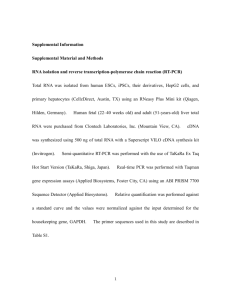
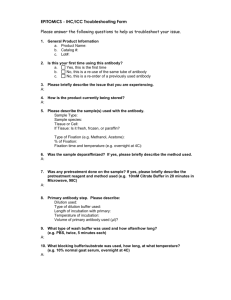

![Anti-PLVAP antibody [MECA-32] ab27853 Product datasheet 3 References Overview](http://s2.studylib.net/store/data/012731941_1-72a4762c09f8db23960912424b5b24e6-300x300.png)
